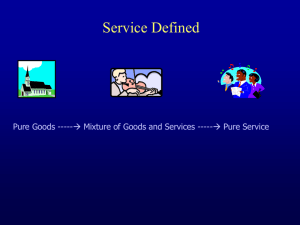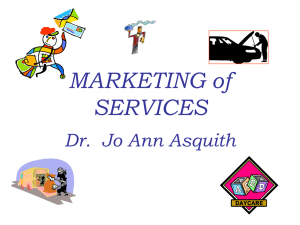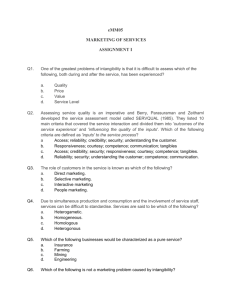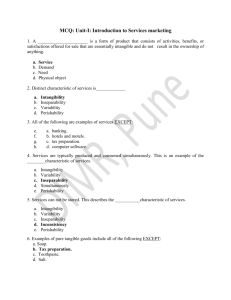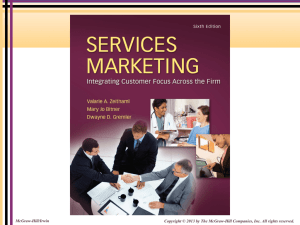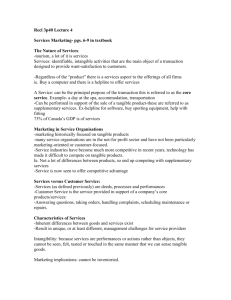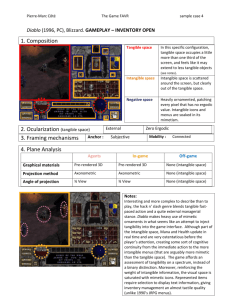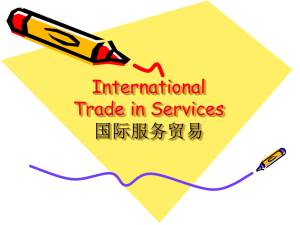Chapter_01
advertisement
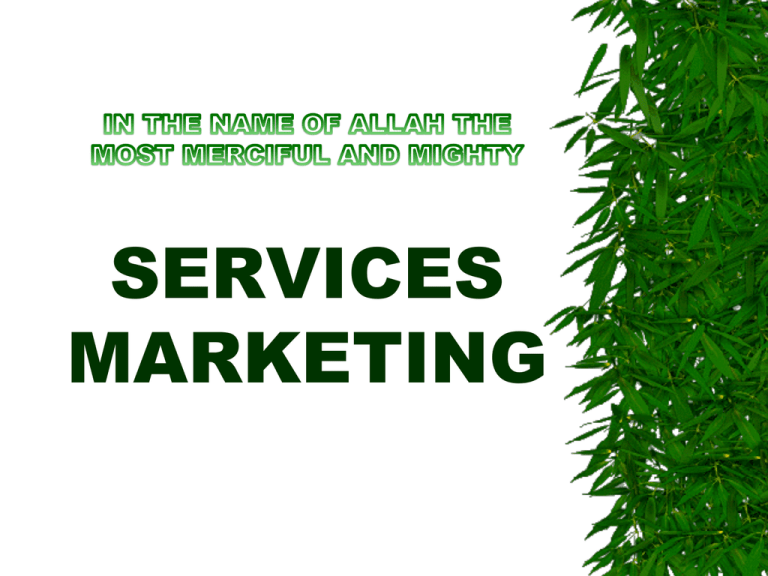
SERVICES MARKETING CHAPTER 1 INTRODUCTION TO SERVICES What is services? All economic activities whose output is not a physical product or construction, is generally consumed at the time it is produced, and provides added value in forms (such as amusement, health) that are essentially intangible concern. Services are divided into four distinct categories. 1) Services industries and companies 2) Services as a product. 3) Customer services. 4) Derived services. 1) Services industries and companies Including those industries and companies typically classified with in the service sector whose core product is service. All of the following companies considered pure service companies… Marriot international (lodging), American Airlines (Transportation), Mayo clinic (Health care). etc 2) Services as Product Represent a wide range of intangible product offering that customers value and pay for it in market place. Services products can sell by services and non services companies such as manufacturers and technology companies. (e.g.) IBM offer information and technology consulting services to the marketplace. Macy’s that sell services such as a gift wrapping and shipping. 3) Customer Services Customer service is the services provided in support of a company’s core products. Company typically do not charge for customer service. Customer service can occur on sites (as when a retail employee helps a customer find a desired item or answers a question), or it can occur via phone or via the internet. 4) Derived Service Steve vargo and Bob Lusch argue for a new dominant logic for Marketing that suggests that all product and physical goods are valued for for the services they provide. Two other authors suggests that the value derived from physical goods is really the service provided by the goods, not the good itself. For Example, they suggest that a pharmaceutical provides medical services, Tangibility Spectrum The broad definition of services implies that intangibility is a key determinant whether an offering is a service. Although this is true, that very few product are very purely intangible are very totally tangible. Instead services tend to be more intangible than manufactured products than to be more tangible than services. For example, the fast food industry, while classified as a services, also has many tangible components such as the food the packing, and so on. Auto mobiles, while classified with in the manufacturing sector, also many intangibles, such as transportation. TANGIBILITY SPECTRUM SALT SOFT DRINK DETERGENT AUTOMOBILES COSMETIC INTANGIBILE DOMINANT TANGIBILE DOMINANT ADVERTISING AGENCIES AIRLINES INVESTMENT MANAGEMENT CONSULTING TEACHING Importance of Services Marketing OR Services in Business 1) First, services marketing concepts strategies have developed in response to the tremendous growth of service industries, resulting in their increase importance to the U.S and world economies. As was noted, in 2003 the service sector represented just over 80 percent of employment and gross domestic product of the united states. Although all the absolute growth in numbers of jobs and the fast growth rates in Job formation are in service industries. 2) Another indicator of economic importance of services is that trade in services is growing world wide. In fact, while the U.S balance of trade in goods remain in the red, in 2000 there was an $81 billion trade surplus in services. World class providers of services such as American Express, McDonald’s and Marriott Hotels, together with many small services companies, are exporting information, Knowledge, Creativity, and technology that the world badly needs. 3) There is a growing market for services and increasing dominance of services in economies worldwide, not just in the united states. The tremendous growth and economic contributions of the services sector industries worldwide. Country Percent of GDP Attributed to services United States 80 United Kingdom 74 Australia 72 France 71 Brazil 54 China 34 4) Services as a Business Imperative in Manufacturing and IT. Early in the development of the field of services marketing and management, most of the impetus came from service industries such as Banking, transportation, and health care. As these service industries evolve and become more competitive, the need for effective services management and marketing strategies continues. Now, however, manufacturing and technology industries such as automobiles, computers and software are also recognizing the need to provide quality service and revenue producing services in order to compete worldwide. Deregulated Industries and Professional Service Needs Specific demand for services marketing concepts has come from the deregulated industries and professional services as both these groups have gone through rapid changes in the way they do business. For example, until 1978 all airline fares, routes, and commission paid to travel agents were determined and monitored by the government. Since that time airlines have been free to set their own pricing structures and determine which routes they will fly. Services Marketing is different As the forces described above coincided and evolved, business people realized that Marketing and managing services issues and challenges not faced in manufacturing and packaged goods companies. These differences and challenges were captured in a series of interviews by Management consultant Garry knisely in 1979. People buy product because they believe they work. But with services, people deal with people they like and they tend to buy because they believe they will like them. Services and Technology Looking to the recent past, it is apparent how technology has been the basic force behind service innovations how taken for granted. Automated voice mail, fax machine, ATMs, and other common services were possible only because of new technologies. Just think how dramatically different your world would be without these basic technology services. Characteristics Of Services Compared To Goods Intangibility. Heterogeneity. Simultaneous Production and Consumption. Perish ability. Intangibility The most distinguishing characteristics of services is intangibility. Because services are performances rather than objects, They cannot be seen, felt, tasted, or touched in the same manner that you can sense tangible goods. Heterogeneity Because services are performances, frequently produced by humans, no two services will be precisely alike. The employees delivering the service frequently are the services in the customer’s eyes, and people may differ in their performance from day to day are even hour to hour. Heterogeneity also result because no two customers are precisely alike, each will have unique demands or experience the service in a unique way. Thus the heterogeneity connected with services is largely the result of human interaction (between and among employees and customers) and all of the vagaries that company it. Simultaneous Production and Consumption Whereas most goods are produced first, then sold and consumed, most services are sold first and then produced and consumed simultaneously. For Example, an auto mobile can be manufactured in Detroit, shipped to Scan Francisco, sold two months later, and consumed over a period of years. But restaurant services cannot be provided until they have been sold, and the dining experience is essentially produced and consumed at the same time. Perishability Parishibility refers to the fact that services cannot be saved, stored, resold, or returned. A seat on an airplane or in a restaurant, an hour of a lawyer’s time, or telephone line capacity not used cannot be reclaimed and used or resold at a later time. Perishability is in contrast to goods that can be stored in inventory or resold another day, or even returned if the consumer is unhappy. Wouldn’t it be nice if a bad haircut could be returned or resold to another customer? SERVICES MARKETING MIX Traditional Marketing Mix One of the basic concepts in marketing is title marketing mix, defined as the elements an organization controls that can be used to satisfy or communicate with customers. The traditional marketing mix is composed of the four Ps product, price, place, and promotion. The notion of a mix implies that all the variables are interrelated and depend on each other to some extent. Price Product Customers Place Promotion However, the strategies for the four Ps require some modifications when applied to services. For example, traditionally promotion is through of as involving decisions related to sales, advertising, sales promotions, and publicity. In services these factors are also important, because services are produced and consumed simultaneously, Services delivery people (such as clerks, ticket takers, nurses, and phone personnel) are involved in real time promotion of the service even if their jobs are typically defined in terms of the operational function they perform. Communication Product/Service Producer/Seller Money Feedback Consumer Expanded Mix for Services Because services are usually produced and consumed simultaneously, customers are often present in the firm’s factory, interact directly with the firm’s personnel, and are actually part of the service production process. Also, because services are intangible, customers will often be looking for any tangible cue to help them understand the nature of the service experience. For example, in the hotel industry the design and decor of the hotel as well as well as the appearance of its employees will influence customer perceptions and experiences. Any Question
